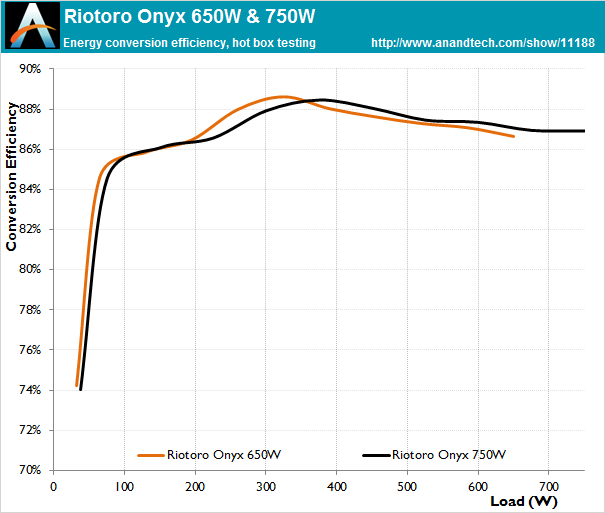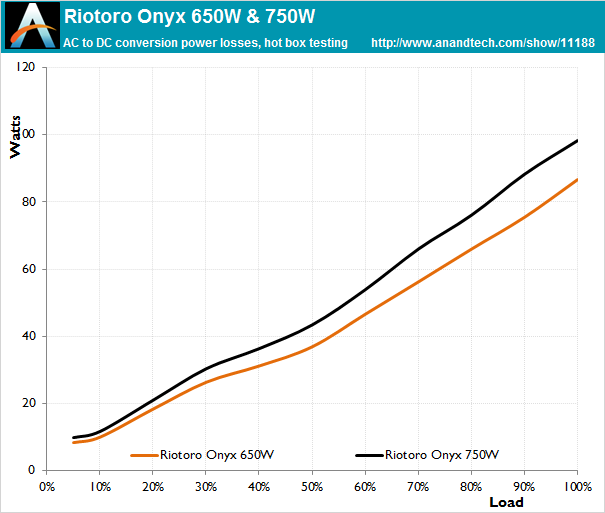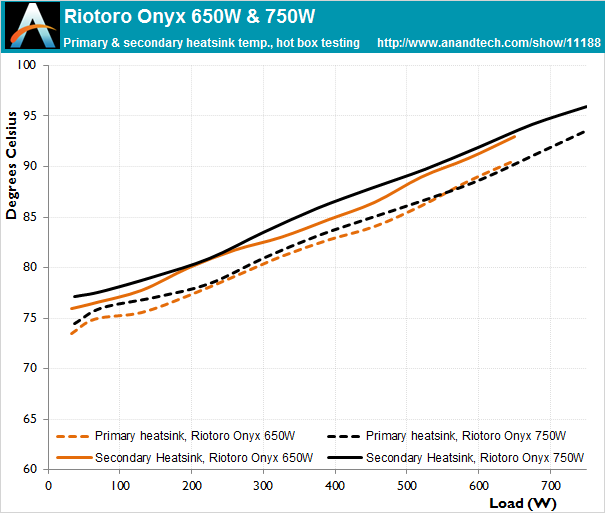The Riotoro Onyx Power Supply Review: 650W & 750W Tested
by E. Fylladitakis on March 23, 2017 10:00 AM ESTHot Test Results
Great Wall’s platform overall delivers a good power quality. As a matter of fact, the platform’s overall performance seems to have improved significantly since the last time we reviewed a similar unit, indicating that the OEM is candidly trying to improve.
| Riotoro Onyx 650W - Main Output | ||||||||
| Load (Watts) | 132.07 W | 329.14 W | 490.17 W | 652.48 W | ||||
| Load (Percent) | 20.32% | 50.64% | 75.41% | 100.38% | ||||
| Amperes | Volts | Amperes | Volts | Amperes | Volts | Amperes | Volts | |
| 3.3 V | 2.16 | 3.39 | 5.4 | 3.38 | 8.11 | 3.37 | 10.81 | 3.35 |
| 5 V | 2.16 | 5.13 | 5.4 | 5.12 | 8.11 | 5.08 | 10.81 | 5.05 |
| 12 V | 9.34 | 12.17 | 23.35 | 12.13 | 35.02 | 12.04 | 46.69 | 12.03 |
| Line | Regulation (20% to 100% load) |
Voltage Ripple (mV) | |||||
| 20% Load | 50% Load | 75% Load | 100% Load | CL1 12V |
CL2 3.3V + 5V |
||
| 3.3V | 1.4% | 8 | 12 | 16 | 24 | 10 | 22 |
| 5V | 1.5% | 8 | 16 | 20 | 30 | 16 | 26 |
| 12V | 1.2% | 16 | 30 | 44 | 52 | 68 | 26 |
We can see that the voltage regulation is significantly improved and very good for PSUs of this class and power range, at 1.2% on the 12V line and lower than 1.5% on the minor lines. The power quality readings are not going to break any performance records, but a maximum voltage ripple of 52 mV and 54 mV on the 12V line of the 650W and 750W models respectively is good, less than half that of the recommended design limit. Both units appear to be a little stressed when heavily cross loaded, with abnormally high ripple appearing on the 12V line, but the reading still do not go anywhere near the 120 mV design limit.
| Riotoro Onyx 750W - Main Output | ||||||||
| Load (Watts) | 152.2 W | 378.21 W | 565.85 W | 751.8 W | ||||
| Load (Percent) | 20.29% | 50.43% | 75.45% | 100.24% | ||||
| Amperes | Volts | Amperes | Volts | Amperes | Volts | Amperes | Volts | |
| 3.3 V | 2.2 | 3.38 | 5.49 | 3.36 | 8.24 | 3.36 | 10.98 | 3.34 |
| 5 V | 2.2 | 5.16 | 5.49 | 5.13 | 8.24 | 5.09 | 10.98 | 5.08 |
| 12 V | 10.98 | 12.15 | 27.45 | 12.08 | 41.18 | 12.05 | 54.9 | 12.01 |
| Line | Regulation (20% to 100% load) |
Voltage Ripple (mV) | |||||
| 20% Load | 50% Load | 75% Load | 100% Load | CL1 12V |
CL2 3.3V + 5V |
||
| 3.3V | 1.4% | 10 | 12 | 14 | 20 | 10 | 20 |
| 5V | 1.5% | 8 | 16 | 22 | 30 | 16 | 22 |
| 12V | 1.2% | 16 | 30 | 46 | 54 | 70 | 24 |
High ambient temperatures have a significant (but not abnormal) impact on the energy conversion efficiency of the Onyx 650W and Onyx 750W PSUs. The average nominal load range (20%-100%) efficiency drops by 0.7% for both units, with the drop almost evenly distributed across the load range, hinting that there are no component quality or stress issues. The nominal load range (20%-100%) efficiency is now 87.3% and, theoretically, both units sustain their 80Plus Bronze efficiency rating even under these operating conditions (the efficiency certifications are being performed with an ambient temperature of 25°C).
A quick glance on the sound pressure level charts shows that the noise levels of the Onyx units are unusually low for units with just an 80Plus Bronze rating. Both units are certainly going to be audible with a load greater than just 200 Watts under these operating conditions, but the noise levels of the fans only slightly surpass 46 dB(A) under maximum load, a relatively low reading taking into account the unit’s power output, efficiency and heatsinks. The reason for this is that the used fan is most likely slightly undersized for the cooling needs of these units, as the internal temperatures do reach uncomfortably high readings when the Onyx PSUs are heavily loaded under these working conditions.















32 Comments
View All Comments
DanNeely - Thursday, March 23, 2017 - link
I thought bitcoin was a bit earlier, must've just been distributed computing projects that did them in. I jumped directly from my GT6800 to GTX260; at which point there were already a decent number of compute projects available to choose from (I'd been running CPU apps via BOINC for several years at that point).kn00tcn - Wednesday, March 29, 2017 - link
xfx may have been the second 'lifetime' or 'double lifetime' brand, though i'm not sure if that was before the amd switch in 2008/2009eriri-el - Friday, March 24, 2017 - link
Don't forget luck playing its usual tricks on us humans. Don't point all ur fingers at the manufaturer/brand alone. My Corsair HX520W is now entering its 10th year of service on my main and only PC. I have been changing and upgrading parts here and there, but I have never seen the need for more power, so I never change it just to see how far it would take me. Maybe one day I'll get something new for more efficiency, but right now I'm just happy it still runs.Sivar - Saturday, March 25, 2017 - link
SeaSonic probably made your Corsair, too.nagi603 - Sunday, March 26, 2017 - link
The first gen Seasonic X series were great, I still have an X400. The latter though... About 1.5 years ago I had a X420 that blew first time I turned it on, and a replacement X400 that refused to turn on about a year later, in a file server that was on maybe 1% of the time. I can only hope the X650 I got instead will last longer.kn00tcn - Wednesday, March 29, 2017 - link
bfg was a dominant nvidia partner like evga is now, to call it some random new company is a complete insult & total ignoranceto not know that many corsair psus are/were built by seasonic is also ignorance
DanNeely - Thursday, March 23, 2017 - link
"The 750W version has two extra PCI Express connectors, plus extra SATA and Molex connectors. Technically, the power rating difference does not really justify such a vast difference on the number of connectors, suggesting that Riotoro simply wanted to differentiate the target group of their two models."The Molex/Sata connectors are almost certainly about differentiation. At potentially 150W per connector 4 6+2 GPU connectors are pushing the limit of what a 650W unit can provide so only putting 2 of them on the smaller one isn't unreasonable. OTOH if they wanted they could've added a single 8 pin GPU connector or 2x 6 pins within the output headroom.
Shadowmaster625 - Thursday, March 23, 2017 - link
Is it that difficult to make a power supply that doesnt give away 10 watts when your machine is idling at 42W?bill.rookard - Thursday, March 23, 2017 - link
It's the span of the wattage that makes it difficult. Not only does the circuitry have to handle generating 50w, it also has to put out 500+ with the exact same design. I'm sure they could design a dual-mode power supply, which has two stages (similar to Arm's BIG.little core designs), but then that's extra components and extra cost, and ultimately for what?Saving 8w of power?
8w of power @ 24/7 is hardly one kw/hr - so it would save you 10c per week, but cost you an extra 50$ for the PSU. That means you'd recoup the savings in 10 years. :)
DanNeely - Thursday, March 23, 2017 - link
The short version is yes. The hardest part of the latest 80+ standard (the first to set a 10% target in addition to the 20-100% ones) is getting the losses from all the fixed power components down, not getting an extra percent or two of efficiency at full load.Broadly speaking your power losses are made up of the sum of a fixed value that's constant when the PSU is turned on and one that grows linearly with power used. Turning the fan on/up and extra losses from hotter parts are why it begins to dip down again at max load.